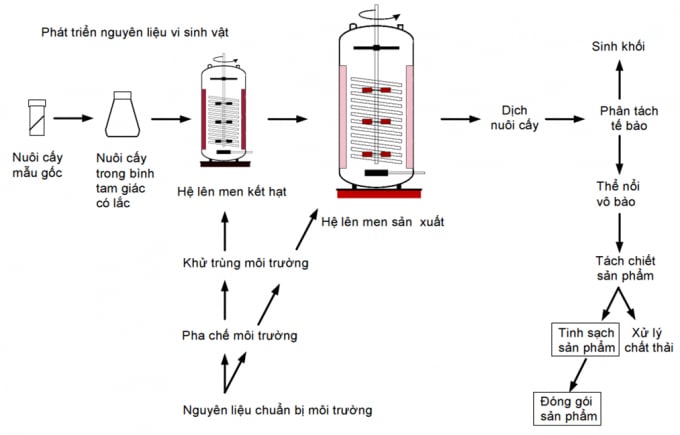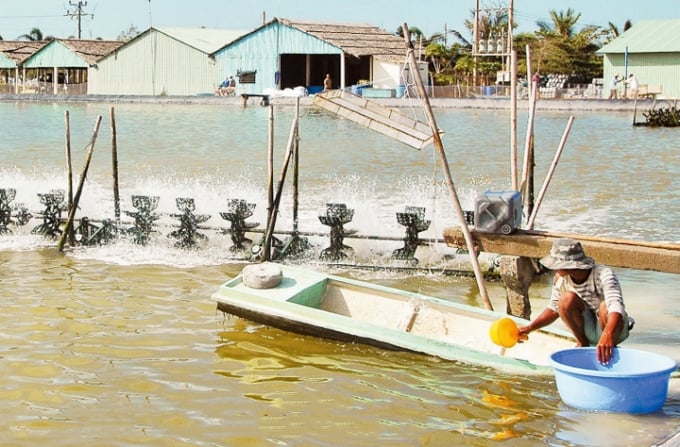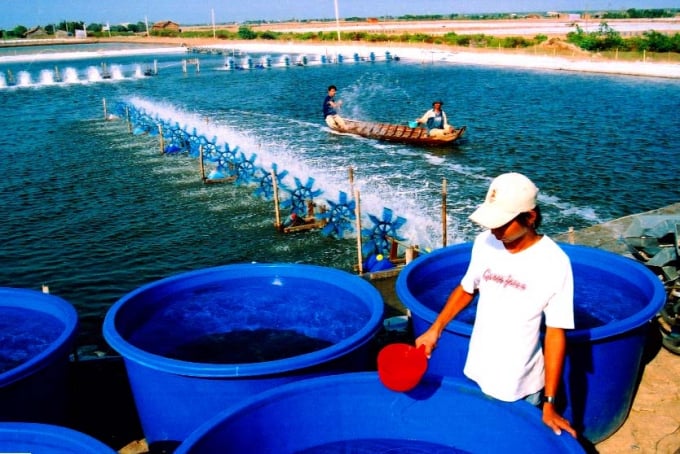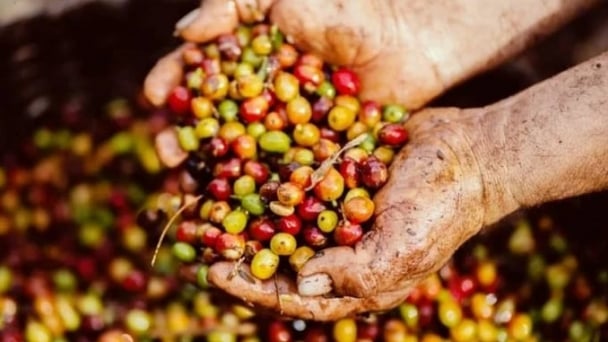June 17, 2025 | 21:49 GMT +7
June 17, 2025 | 21:49 GMT +7
Hotline: 0913.378.918
June 17, 2025 | 21:49 GMT +7
Hotline: 0913.378.918
The term “probiotic” has been defined as “single or mixed cultures of live microorganisms that have beneficial effects on the host by improving the properties of the native microbiota”.
Scientists later extended this definition to aquaculture by including the introduction of natural bacterial species into aquaculture tanks/ponds.

Some microorganisms with the ability to metabolize NH3 and H2S compounds have been applied in aquaculture. Graphics: Nguyen Tan Sy.
According to Dr. Nguyen Tan Sy, Deputy Director of the Institute of Aquaculture (Nha Trang University), probiotics are a type of beneficial bacteria belonging to the group of live bacteria and living microorganisms, mainly bacteria, similar to beneficial microorganisms naturally found in the gut. They are also known as "friendly bacteria" or "good bacteria". These bacteria are added to the diet to balance the intestinal flora and improve health.
Probiotics are live microorganisms that are beneficial to the host's health when taken in adequate amounts. Beneficial bacteria (probiotics) improve the health of shrimp or fish by controlling pathogenic bacteria species and improve water quality by changing the composition of bacteria groups in the water and pond bottom.
Many establishments and businesses have applied microbial technology to produce products on an industrial scale, in which the direct and decisive factor is microbial cells. Each living cell of the microbial organism operating in this production field is seen as a small reactor.
Microbial technology is a branch of biotechnology. It is a process of producing biological products applied fermentation technique via the activities of microorganisms in the process of biological reactions.
The whole process of microbiological technology starts from breeding, propagation, fermentation, collection and product purification. Those stages must follow a certain order and have a decisive influence on each other in the whole system.
The separation of each stage or the lack of synchronization in the whole system leads to low productivity of the whole process.

Some microorganisms have the ability to secrete antibiotics to inhibit or kill harmful bacteria. Graphics: Nguyen Tan Sy.
According to scientists, in terms of safety, microorganisms must have a clear origin and be identified with species and strains. The microorganisms are carefully selected and stored under strict conditions. Every year, microorganisms are evaluated for stability, biochemical and genetic properties.
To be applied in aquaculture, microorganisms must be able to adapt well to environmental conditions including salinity, ambient temperature, pond water pH, aerobic conditions, and light conditions. In particular, the microbial activity must be high, especially the ability to decompose organic substances (protein, starch, fiber...), the ability to metabolize nitrogen and H2S compounds, and the ability to assimilate diverse carbohydrate groups.
Accordingly, the group capable of metabolizing NH3 and H2S compounds is Rhodobacter. The use of these beneficial bacteria to manage the microflora in the pond has the effect of cleaning the pond bottom, decomposing organic matter, absorbing dead algae, reducing the increase in the pond sludge; inhibiting the activity and growth of harmful bacteria; and converting toxic gases harmful to shrimp such as NH3, NO2, H2S...
Therefore, it helps to stabilize algae and pond water color. Some strains of bacteria will increase oxygen content and stabilize pH and environmental indicators in ponds. The use of Biofloc culture also successfully manages the microflora in the pond.

General diagram of the microbial fermentation process in the production of microbial products. Graphics. Nguyen Tan Sy.
In addition, some species of microorganisms have the ability to inhibit pathogenic bacteria by secreting antibiotics (anti-Escherichia, anti- micrococcus, anti- Salmonella enterica, anti- S. aureus, anti- Vibrio sp ...) or competing for nutrients, lowering the pH...
Currently, EM (Effective Microorganisms), product of Prof. Dr. Teruo Higa, University of the Ryukyus, Japan) include 80 species of anaerobic and aerobic microorganisms, selected from 2,000 species that are commonly used in the food industry and fermentation industry, including: photosynthetic bacteria, lactic acid bacteria, yeasts, actinomycetes, and filamentous fungi.

Currently, the application of probiotics has made shrimp farming safer against diseases. Photo: MP.
In aquaculture, EM microbial products help to increase resistance and tolerance to external conditions, improve digestion and absorption of foods, increase reproductive stimulation, productivity and quality and quantity of livestock, while destroying harmful microorganisms and limiting environmental pollution. Miraculously, EM has a good effect on all domestic animals and all aquatic animals.
To produce EM2 from original EM (with a 50 l container), we sterilize the containers then fill it with 46 liters of fresh, clean water, 1 kg of molasses (stir well), then add 2 kg rice bran or corn flour (stir well), add 50g of salt (stir well) and 1 liter of original EM (stir well), then cover it with anaerobic incubation for 7 days. With a larger volume (100l, 200l, 500l…), the increase of materials is proportional to the volume.
To treat water, we use 50 liters of EM2 for 1,000 m3 of water. 10 liters of EM2 is used to treat 1,000 m2 of pond bottom. If used periodically in ponds, 50 liters of EM2 is used for 1,000m3 of water. In the first month, it should be used 7 days/time, 5 days/time in the 2nd month and 3 days/time from the 3rd month onwards. In case of stench treatment, EM2 should be sprayed directly on the surface of the places where the stench is generated.

Some microbial products are very effective in preventing diseases in aquaculture, especially shrimp farming. Photo: MP.
According to Dr. Nguyen Tan Sy, original EM could also be used to prevent and treat some fish and shrimp diseases with probiotics. Specifically, to handle shrimp and fish floating due to toxic gas, farmers dissolve 2 - 3 liters of original EM into 20 liters of water taken from the pond, then pour it into the pond as soon as the shrimp are floating and turn on the fans at full capacity.
If shrimp have worn tail and lost antennae, farmers could use 2 liters of garlic EM to mix well with 10 kg of feed and incubate for 4 hours, and then feed shrimp at the rate of 1kg/100,000 shrimp seed/day, or use 50 liters of EM2 for 1000m2 per day and 3 times in a row with a 2-day interval.
Translated by Phuong Ha
![Turning wind and rain into action: [7] Early disaster warnings help marine farmers minimize losses](https://t.ex-cdn.com/nongnghiepmoitruong.vn/608w/files/news/2025/06/17/z6704423696987_15fd32ffc26d590d204d520c9dac6786-nongnghiep-142942.jpg)
(VAN) In recent years, thanks to early disaster warnings and forecasting, marine farmers in Khanh Hoa province have been able to reduce risks and losses, thereby improving production efficiency.
![Turning wind and rain into action: [5] Hue applies modern technology in disaster forecasting](https://t.ex-cdn.com/nongnghiepmoitruong.vn/608w/files/news/2025/06/17/z6704423696987_15fd32ffc26d590d204d520c9dac6786-nongnghiep-093938.jpg)
(VAN) In Hue city, modern technology has recently been applied in meteorological and hydrological forecasting and warning, helping to reduce the damage caused by natural disasters.

(VAN) A cutting-edge farming technique being implemented on an experimental ranch in Arizona's Sonoran Desert has already saved a billion gallons of water over five years, according to Civil Eats.

(VAN) Poultry and pig production and the environment can be boosted through enhanced water technology, according to new research.

(VAN) Coffee prices on June 16, 2025 are unchanged. In Vietnam, local trading prices are holding steady, ranging around VND 112,000 – VND 112,500/kg.
![Turning wind and rain into action: [4] Bringing climate bulletins to remote and isolated areas](https://t.ex-cdn.com/nongnghiepmoitruong.vn/608w/files/linhnhp/2025/06/14/1152-z6704423696987_15fd32ffc26d590d204d520c9dac6786-nongnghiep-151141.jpg)
(VAN) The Vietnam Agriculture and Nature Newspaper interviewed Mr. Vu Thai Truong, Acting Head of Climate Change and Environment at UNDP Vietnam, to gain deeper insight into how climate bulletins are delivered to farmers.

(VAN) In Tien Giang, a high-tech shrimp farm has developed a distinctive energy-saving farming model that has yielded promising results.